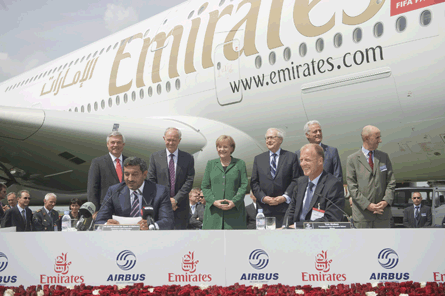Emirates' aggressive Airbus A380 fleet expansion plan has been validated by analysts at the Royal Bank of Scotland, who do not expect the Gulf carrier to struggle to find enough viable routes on which to deploy its 90 aircraft. This independent verification comes as the Dubai-based airline's president Tim Clark explains that there is the potential to buy another 30 A380s.
In a research note dubbed "What would you do with 90 A380s?" - that also examines the wider fleet and network expansion of Emirates - RBS concludes that its 2020 fleet will be "modest" compared with airlines such as Air France-KLM and United/Continental. This is despite its study forecasting the carrier will place yet more orders in the second half of the current decade and into the following decade.
The report addresses growing unrest among legacy carriers about the rise of the Gulf carriers. RBS concludes that these fears are overstated. "We expect the Gulf carriers to leverage their geographic advantage and focus their growth on traffic flows linking India, China, Africa and the Mid East," says RBS.
 |
|---|
© Billypix |
"The real price of Gulf growth will not be an industry meltdown but will be a cap on European carriers' ability to leverage the potential growth from the Indian market," it adds.
Emirates faced cynicism last June when it placed the single biggest A380 order, with a deal for 32 of the type, taking its total order for the 500-seater to 90.
However, the RBS report supports the airline's growth strategy and, based on a hypothetical network and fleet plan to 2020, forecasts a growing share for Emirates in several key markets.
RBS foresees Emirates adding 21 new destinations to its network by 2015, based on the assumption it will have taken delivery of 60 A380s, 23 A350s and 109 Boeing 777s by that time. The hypothetical schedule sees the carrier focusing its A380s on routes to Australia, Europe, the USA, China and Japan.
HEAVIER EMPHASIS
By 2020, RBS expects Emirates to add a further 25 new destinations, with a heavier emphasis on south Asia and North America. This assumes all 90 A380s will be in operation by this time, in addition to 70 A350s and 67 777s.
The report predicts Emirates' total fleet will increase to 249 aircraft in 2020 from 155 in 2010.
"This is notably more modest than one might expect, given the media discussion around Emirates' high-growth plans," says RBS, noting that this compares with a current 722-strong fleet at Lufthansa Group and a 1,261-strong fleet at United/Continental.
"These figures are boosted by large portfolios of regional aircraft but the scale of the Emirates fleet, on our modelling, would be modest," it adds.
Clark says the RBS study backs up what Emirates has said "for a long time", but sceptics remain. When asked during a meeting in early February by the US deputy transportation secretary where Emirates would fly all its A380s, Clark says he showed how easy it was to find homes for 90 units.
"That 90 is gone," he says, citing the number of Emirates long-haul routes that are A380 capable, including Melbourne, Sydney, Auckland, Brisbane, San Francisco and New York. "We don't get the last one until November 2017. I wish we could have more next week, but we can't."
New York and Auckland are already among the 12 routes Emirates currently serves with its 15 A380s. Clark says "the map actually takes you to 120", but Emirates cannot order a further 30 aircraft for now because it cannot physically fit in any more A380s at its Dubai hub.
"The constraint is what we can do physically in Dubai airport," he says. "We're working on it."
Source: Airline Business



















